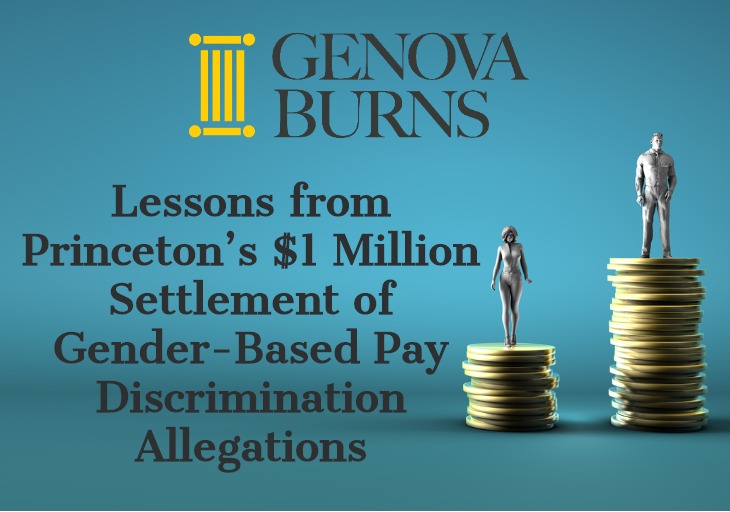Lessons from Princeton’s $1 Million Settlement of Gender-Based Pay Discrimination Allegations
November 6, 2020
Princeton University recently agreed to pay nearly $1 million in cumulative back wages to 106 female professors who The U.S. Department of Labor’s Office of Federal Contract Compliance Programs (OFCCP) found to be victims of gender-based pay discrimination.
OFCCP’s Jurisdiction & Enforcement of the Compensation Discrimination Law
OFCCP enforces Executive Order 11246, which makes it unlawful for employers who are government contractors to engage in gender-based compensation discrimination. To assess compliance with this law, OFCCP regularly conducts aggressive, protracted reviews of contractors’ pay practices. These reviews are called compliance evaluations. An employer who is found, during the course of an OFCCP compensation compliance evaluation, to pay female employees less than similarly situated male employees, may be in violation of the law absent a legitimate, non-discriminatory explanation for the pay disparity, such as seniority. OFCCP can pursue legal remedies against these employers, including backpay and benefits, costly salary adjustments, and nonmonetary relief including mandatory promotions or job placements, modifications of policies and practices, pay equity training, and more harshly, the cancellation of current federal contracts and exclusion from future contracts.
“Similarly situated” is a term of art. When OFCCP evaluates employee pay, it is theoretically supposed to compare the pay of only similarly situated employees, meaning individuals who one would expect be paid the same based generally on the similarity of: (a) their jobs, such as daily tasks, required skills, effort, responsibility, and complexity; and (b) other objective factors, such as minimum qualifications or certifications. As the thinking goes, persons in jobs requiring certain credentials should not be grouped together with persons in jobs that do not require those same credentials, even though the two jobs otherwise may be similar. For example, one would expect a college professor, required to have a PhD and who regularly teaches classes, to be paid more than his/her teaching assistant, who likewise regularly teaches but has not yet obtained his/her PhD. Comparing the pay of a group of professors to that of a group of teaching assistants would be like comparing apples to oranges.
Princeton University’s Alleged Violation
In Princeton’s case, OFCCP conducted a university-wide review of all full professors’ compensation. At first glance, this seems to be more like comparing apples with apples. OFCCP considered all of Princeton’s full professors to be similarly situated. According to OFCCP’s preliminary findings, 106 of Princeton’s female full professors were paid lower salaries than their similarly situated male counterparts between 2012 and 2014. Princeton did not admit wrongdoing, and it did not attempt to justify the alleged pay disparity with legitimate, nondiscriminatory factors. Instead, it seems Princeton asserted that the OFCCP’s findings were the result of a flawed model based on improper comparisons.
Princeton contended that not all full professors were similarly situated to one another, and only full professors within each academic department were similarly situated. Princeton claimed that a professor’s compensation varied depending on what department he/she was in because professors teaching one academic discipline produce a labor market different than professors who teach other disciplines. For example, astronauts might be more employable than jazz musicians. Therefore, professors teaching astrophysics are compensated differently than those teaching jazz studies. Princeton’s department-based approach to faculty compensation accounted for market factors that it claimed OFCCP’s process did not consider. Thus, as Princeton claimed, OFCCP’s inclusion of all full professors in one pool of similarly situated employees created a false impression of pay inequity.
The Settlement Agreement
Attacking OFCCP for the sample of employees whose pay it compared during a compensation compliance evaluation is a method that has been both successful and unsuccessful in defending against allegations of pay inequity. However, to avoid the burdens and expense of further legal proceedings fighting over whether OFCCP mixed up Princeton’s apples with its oranges, Princeton entered into an early resolution conciliation agreement with OFCCP. Princeton agreed to reconcile the alleged pay disparity by paying $925,000 in back wages as restitution to the 106 female professors. Princeton also agreed to other measures, including conducting internal pay equity audits in the future, actively hiring women into roles where they are typically underrepresented, and conducting pay equity training for all personnel involved in compensation decisions for full professors.
All Employers Beware, Even Non-Government Contractors
OFCCP has recently ramped up enforcement efforts. But federal contractors are not the only employers potentially liable for compensation disparities. There are several federal and state laws that expose most employers to liability. Included among them is the federal Equal Pay Act, which requires equal pay to men and women who perform jobs that require equal skill, effort and responsibility, violations of which expose employers to liquidated damages and the payment of attorneys’ fees. New Jersey’s Diane B. Allen Equal Pay Act, considered to be the most aggressive equal pay law in the country, requires equal pay to members within and outside of all protected classes (e.g., race, disability, age) who perform substantially similar work (as opposed to equal work).
The Takeaway
It is a difficult task for employers to comply with all of the laws requiring equal pay and prohibiting discrimination in compensation. One strategy employers might consider is conducting an internal pay equity self-audit with legal counsel. In certain jurisdictions, this might trigger safe harbor protections in the event of litigation. More importantly, it may proactively uncover pay disparities within your organization that you can reconcile now to avoid litigation later.
For more information about how to conduct an internal pay equity audit and other compensation-setting strategies, please contact Chair of Genova Burns’ Employment Law and Litigation Practice Group, John C. Petrella, via email at jpetrella@genovaburns.com, or Justine L. Abrams, Esq. here.
Tags: GENOVA BURNS LLC • John C. Petrella • Justine Abrams • Gender Equality • Princeton University • OFCCP

